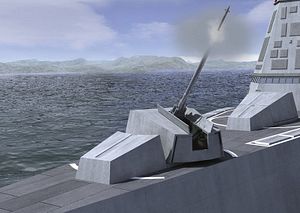The U.S. Navy is looking to replace the primary projectile used for the two main guns of its 16,000-ton next generation guided-missile destroyer USS Zumwalt (DDG 1000). With a cost of $800,000 to $1 million per Long Range Land Attack Projectile (LRLAP) round, the precision ammunition has become too expensive for the service.
LRLAP is the only ammunition specifically designed to be fired by the USS Zumwalt’s two 155 millimeter/62-caliber Advanced Gun Systems (AGS), the main armament of the ship with an estimated range of up to 63 nautical miles (72 miles, 115 kilometers).
According to sources interviewed by Jane’s Defense Weekly, the U.S. Navy is now exploring possible replacement projectiles. The service is considering three options: Raytheon’s 155 millimeter Excalibur 1b, BAE Systems’ Multi-Service Standard Guided Projectile (MS-SGP), and the Hyper Velocity Projectile (HVP).
According to the Raytheon website, Excalibur is “a true precision weapon, impacting at a radial miss distance of less than two meters from the target” and “provides accurate first-round effects at all ranges in all weather conditions.” Raytheon is in the process of developing a 5-inch naval variant of the projectile, the Excalibur N5 munition.
“This sea-based projectile is expected to more than double the maximum range of conventional 5-inch munitions and will provide the same accuracy as the land-based version,” Raytheon claims. The Excalibur’s range is around 21 nautical miles (25 miles) and the cost for one Excalibur round is $68,000, although some analysts have estimated that including R&D costs for a new AGS variant, the price could increase to $250,000.
The MS-SGP, the BAE Systems website claims, “will deliver 5-inch fires at a maximum rate of 10 rounds per minute to 52 nautical miles to achieve desired effects. The 5-Inch Multi-Service-SGP offers rapid time of flight and the capability of in-flight retargeting to address moving targets, changing target conditions, and surface threats.” The ammunition is not yet in production. “Tested component designs are based on a spiral of the highly successful 155-mm Long Range Land Attack Projectile (LRLAP),” according to BAE Systems.
The HVP, designed to be fired from an electromagnetic railgun, which uses electromagnets to shoot the projectile at over Mach 7 to ranges over 100 nautical miles, is still under development. As The Diplomat’s Steven Stashwick notes, “the HVP is the round designed for the EMRG [electromagnetic railgun], but that can also be fired from existing naval cannons using traditional gunpowder propellant. Shot from a conventional naval gun, the HVP’s range is almost 50 nautical miles — over twice the effective range of current naval artillery, and with substantially greater accuracy.”
Out of the three options, Jane’s Defense Weekly claims, the U.S. Navy favors the Excalibur because it is already in production, although the naval variant is still in its testing phase. However, as I noted in November (See: “US Navy’s Most Advanced Stealth Warship Has No Bullets for Its Big Guns”), the service has so far not made an official announcement whether it will go through with the cancellation of the LRLAP and no decision has been made on selecting an alternative to the LRAP.
“The Navy continuously monitors the gun and ammunition industry capability and capacities. To address evolving threats and mission requirements, the Navy is evaluating industry projectile solutions (including conventional and hyper-velocity projectiles) that can also meet the DDG 1000 deployment schedule and could potentially be used as an alternative to LRLAP for DDG 1000,” a U.S. Navy spokesperson told USNI News on December 12. (A spokesman issued a similar statement to Defense News on November 4.)
The principle question remains in what way AGS’s magazine and loading system will need to be modified. According to a Pentagon official cited by USNI News, it would cost around $250 million to modify the guns on all three ships of the class for a new projectile.
The USS Zumwalt was commissioned on October 15, and is the lead ship of a class of three new warships (See: “US Navy Commissions Most Technologically Advanced Stealth Warship”). The ship has suffered a number of engineering casualties over the last months.

































